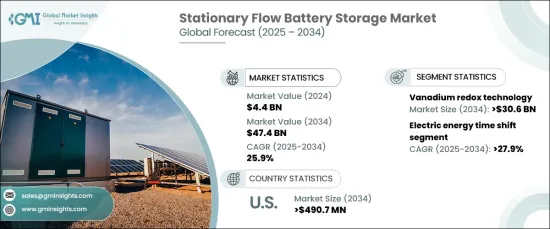
전 세계 고정형 플로우 축전지 시장은 2024년 44억 달러 규모로 2034년까지 연평균 25.9%의 성장률을 기록하며 비약적인 성장을 이룰 것으로 예상됩니다.
이러한 견조한 성장은 계통 안정성을 높이면서 재생에너지원을 통합하도록 설계된 대규모 에너지 저장 시스템에 대한 수요 증가를 반영합니다. 세계 각국이 청정에너지로의 전환을 가속화하는 가운데, 플로우 배터리는 간헐적인 재생에너지 발전의 문제를 해결하기 위한 핵심 기술로 부상하고 있습니다. 이 배터리는 장시간의 에너지 저장, 확장성, 긴 사이클 수명 등 뛰어난 장점을 가지고 있어 실용적인 규모의 애플리케이션에 필수적인 요소로 자리 잡고 있습니다.

주요 시장 촉진요인으로는 탈탄소화를 향한 세계 추진력, 정부 인센티브, 비용 절감 및 성능 향상을 위한 기술 발전 등이 있습니다. 기후변화와 에너지 안보에 대한 우려가 커지면서 고정형 플로우 배터리는 마이크로그리드, 부하 분산, 그리드 안정화 등 에너지 집약적인 애플리케이션에 적합한 선택이 되고 있습니다. 이러한 시스템은 풍력 및 태양광발전으로 생성된 잉여 에너지를 효과적으로 저장하여 발전량이 적은 기간 동안 안정적인 전력 공급을 제공합니다. 모듈식 설계와 지속가능성은 재생에너지 통합 및 탄소 중립이라는 세계 목표에 완벽하게 부합하는 모듈식 설계와 지속가능성이 그 매력을 더욱 높여줍니다.
| 시장 범위 | |
|---|---|
| 시작 연도 | 2024년 |
| 예측 연도 | 2025-2034년 |
| 시작 금액 | 44억 달러 |
| 예상 금액 | 474억 달러 |
| CAGR | 25.9% |
플로우 배터리 기술 중에서도 바나듐 레독스 플로우 배터리는 2034년까지 306억 달러 규모의 시장을 창출할 것으로 예측되는 게임 체인저로 주목받고 있습니다. 이 배터리는 높은 에너지 효율, 긴 사이클 수명, 확장성으로 높은 평가를 받고 있습니다. 다른 유형의 배터리와 달리 바나듐 산화물 배터리는 두 전해질 모두 동일한 원소를 사용하기 때문에 상호 오염을 방지하고 장기간 안정적인 성능을 보장할 수 있습니다. 유지보수의 필요성이 낮고, 안정적인 장기 에너지 저장이 가능하기 때문에 전 세계 재생에너지 프로젝트에서 널리 채택되고 있습니다. 태양광발전과 풍력발전이 계속 확대됨에 따라 바나듐 산화물 전지의 수요는 급증할 것이며, 시장에서의 우위는 더욱 확고해질 것입니다.
그리드 관리의 핵심 요소인 전기 에너지의 타임 시프트 애플리케이션은 2034년까지 27.9%의 CAGR로 성장할 것으로 예상됩니다. 이 혁신적인 애플리케이션은 오프피크에 생산된 잉여 에너지를 저장하고 수요가 많은 시간대에 이를 배포할 수 있게 해줍니다. 계통의 불균형을 해결하고 에너지 신뢰성을 향상시킴으로써 타임시프트 솔루션은 재생에너지 도입을 지원하고 탈탄소화 목표를 달성하는 데 매우 중요한 역할을 할 수 있습니다. 에너지 효율과 신뢰성에 대한 관심이 높아짐에 따라 이러한 애플리케이션의 중요성이 커지고 있습니다.
미국에서는 2034년까지 4억 9,070만 달러 규모의 고정형 플로우 축전지 시장이 형성될 것으로 예상됩니다. 이러한 급격한 성장은 재생에너지의 보급과 국가 전력망 현대화 노력에 힘입은 바 큽니다. 대용량의 에너지를 장기간 저장할 수 있는 플로우 배터리는 재생에너지의 간헐성의 균형을 맞추기 위해 필수적입니다. 세액 공제 및 금융 혜택을 포함한 연방 및 주정부 차원의 정책은 피크 차단, 부하 평준화, 계통 탄력성 강화와 같은 중요한 용도에 플로우 배터리 시스템의 도입을 가속화하고 있습니다.
The Global Stationary Flow Battery Storage Market, valued at USD 4.4 billion in 2024, is poised to witness exponential growth with a projected CAGR of 25.9% through 2034. This robust expansion reflects the increasing demand for large-scale energy storage systems designed to integrate renewable energy sources while enhancing grid stability. As nations worldwide accelerate their transition toward clean energy, flow batteries are emerging as a vital technology for addressing the challenges posed by intermittent renewable energy generation. These batteries offer exceptional benefits, including long-duration energy storage, scalability, and extended cycle life, making them indispensable for utility-scale applications.

Key drivers of the market include the global push toward decarbonization, government incentives, and technological advancements that are reducing costs and improving performance. With growing concerns over climate change and energy security, stationary flow batteries are becoming a preferred choice for energy-intensive applications, such as microgrids, load balancing, and grid stabilization. These systems effectively store excess energy generated by wind and solar power, delivering a steady power supply during periods of low generation. Their modular design and sustainability further enhance their appeal, aligning perfectly with global objectives for renewable energy integration and carbon neutrality.
| Market Scope | |
|---|---|
| Start Year | 2024 |
| Forecast Year | 2025-2034 |
| Start Value | $4.4 Billion |
| Forecast Value | $47.4 Billion |
| CAGR | 25.9% |
Among flow battery technologies, vanadium redox flow batteries stand out as a game-changer, with the segment projected to generate USD 30.6 billion by 2034. These batteries are celebrated for their high energy efficiency, long cycle life, and scalability. Unlike other battery types, vanadium redox batteries utilize the same element for both electrolytes, preventing cross-contamination and ensuring stable performance over time. Their low maintenance requirements and ability to provide reliable, long-duration energy storage are driving the widespread adoption in renewable energy projects worldwide. As solar and wind power continue to expand, the demand for vanadium redox batteries is set to surge, further solidifying their dominance in the market.
The electric energy time-shift application, a critical component of grid management, is anticipated to grow at an impressive CAGR of 27.9% through 2034. This innovative application enables the storage of excess energy produced during off-peak hours, allowing it to be deployed during periods of high demand. By addressing grid imbalances and enhancing energy reliability, time-shifting solutions play a pivotal role in supporting renewable energy adoption and achieving decarbonization goals. The growing emphasis on energy efficiency and reliability underscores the increasing importance of these applications.
In the United States, the stationary flow battery storage market is expected to reach USD 490.7 million by 2034. The rapid expansion is fueled by the widespread adoption of renewable energy and initiatives to modernize the national power grid. Flow batteries, with their unparalleled ability to store large energy volumes for extended durations, are essential for balancing the intermittency of renewables. Federal and state-level policies, including tax credits and financial incentives, are accelerating the deployment of flow battery systems for critical applications such as peak shaving, load leveling, and grid resilience enhancement.